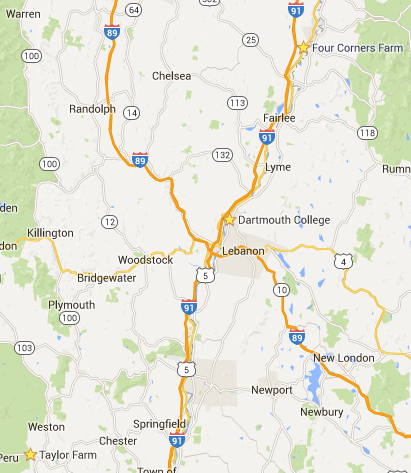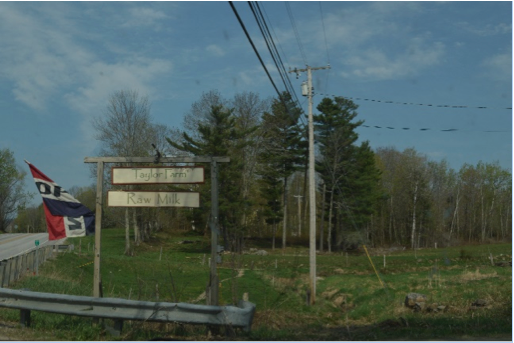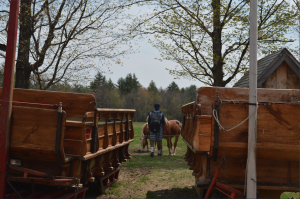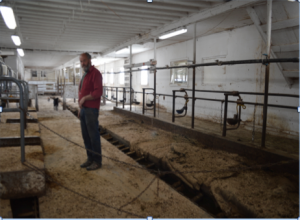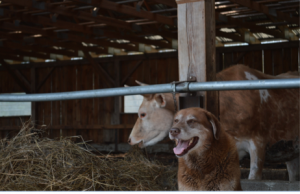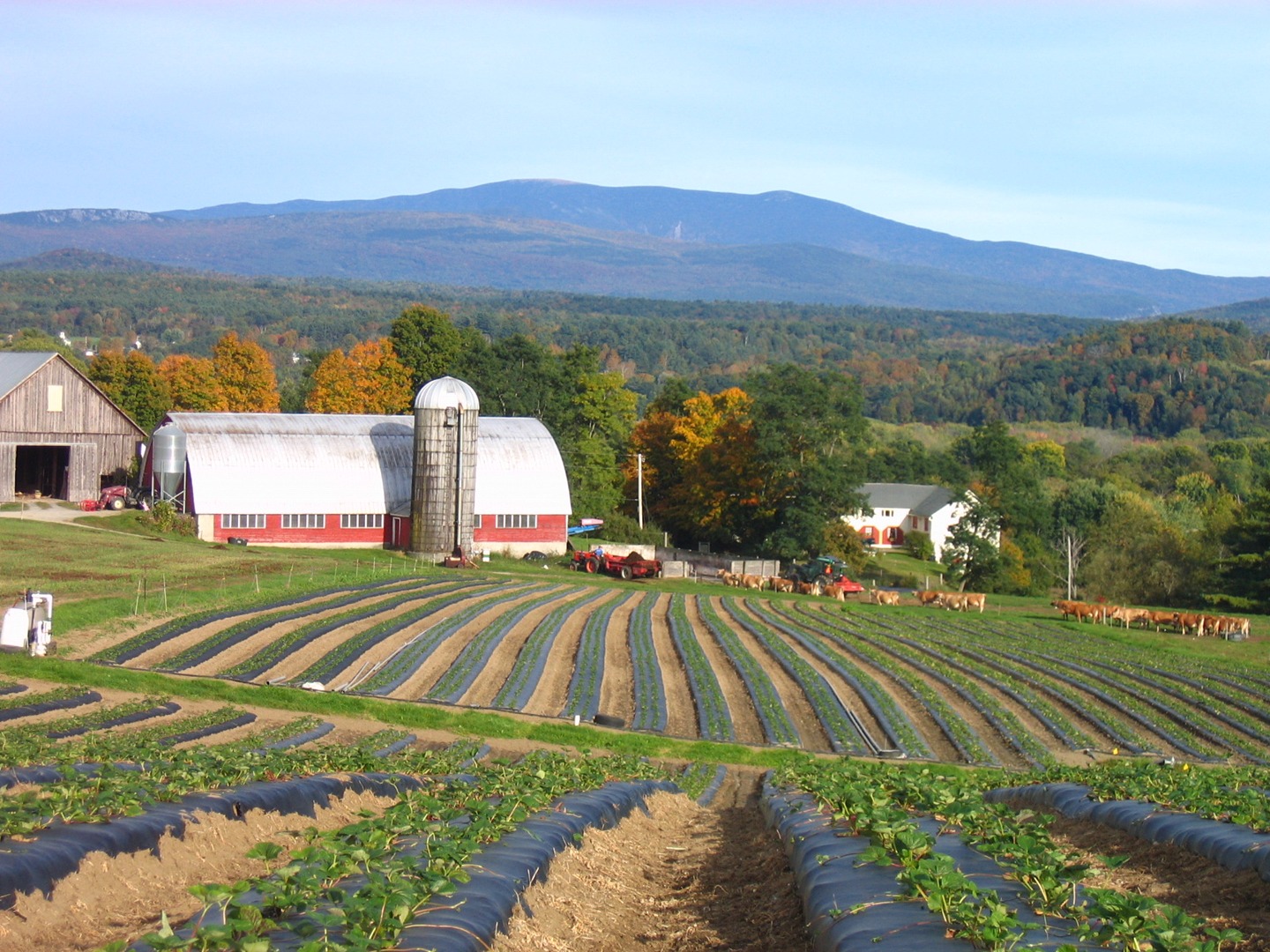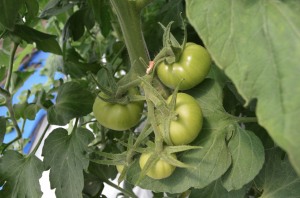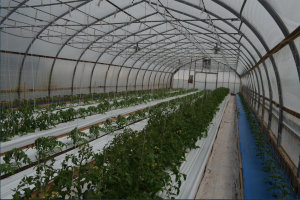Overview
Vermont is home to over 7000 farms, leading the nation in farmers markets and farm stands per capita. Taylor Farm and 4 Corners Farm both make it their top priority to supply goods from a wide variety of products to shoppers in rural Vermont and New Hampshire. While Taylor Farm offers high-quality cheese and dairy products to customers in the Vermont area, 4 Corners Farm offers fresh fruits and vegetables to its Upper Valley customers. By doing so, these farms reflect the intimate agricultural relationship between the local community and farmers. They are valued not only by the products that they produce, but also by the tradition that is embodied in them. As you explore the farms, it will be easy to note the ways that these farms and their farmers interact with the landscape and how said landscape reflects not only the food they produce, but also the manner in which they use the farms to make their living. The two farms are different in their production output, but similar in the way that their everyday choices reflect their environment. Farming is vital to food production and during your trip to these farms, be sure to consider the life of a farmer, and the nature of using farming to make a living.
After visiting these farms, hopefully you will have a greater understanding of the demand for local products from small northern New England farms and the processes of producing these foods, as well as gaining insight into the life of a farmer and the unpredictable nature of the occupation.
Taylor Farm
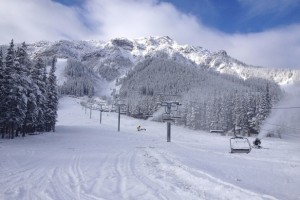
A shot of Okemo Mountain Resort in the winter.
To reach the Taylor Farm from Hanover, New Hampshire, you’ll need to head west on Wheelock Street and cross the Ledyard Bridge into Vermont. From there, hop on Interstate-91 and head south forty miles until you hit exit 8. Then proceed to take a right onto route 131 west. In the town of Ludlow, Vermont, take a left onto route 100 south. Follow the road a few miles; after passing through the town of Londonderry, the farm will be on your right. On the route to the Taylor Farm, you will pass through several small New England towns. As you drive through Ludlow, you will be able to point out Okemo Mountain Resort off in the distance. Also, notice the businesses in the town and to whom they are geared. For example, the motels and ski gear shops target vacationers visiting the resort. Lastly, on the way to Taylor Farm, note the many small market places, village stores and general stores that serve people in the local communities and people visiting from other parts of the country. You will also pass through several small towns, like Cavendish, Vermont, that consist of easily-recognized town commons such as open greens and recreational areas.
Taylor Farm is a 180-year-old farm located on Route 11 in Londonberry, Vermont. Being part of the Vermont Land Trust, it is assured that the land on which Taylor Farm resides on will always be used for agriculture. Upon arriving at Taylor Farm, first visit the shop where their nationally recognized gouda cheese is sold. According to John, the head farmer there and the brains behind converting a simple dairy farm into a famous cheese farm, maintaining small farms and having small local production within the community could very well play a vital role in the future. John is one of fifty cheese makers in Vermont, the state with the most cheese farms per capita than anywhere else in the country.
Besides making cheese, one of John’s main sources of income comes from milking cows. John and employees milk cows and then sell the milk to cooperative firms such as Agrimark. Agrimark is a broker: it buys milk from farmers and then sells it to big retail companies such as Cabot Cheese. According to John, the upper echelon retail companies achieve most of the profit from selling the milk, and the farmers get whatever is left over. This led John to go into cheese production fifteen years ago, which is far more profitable than selling milk.
John explained that the cheese must age for two months due to Vermont law, but the two month wait is worth it. He can either sell 100 pounds of milk for $17 total or convert the 100 pounds of milk into roughly ten pounds of cheese, which can be sold at $16 per pound. Converting the raw milk into cheese yields a higher profit for John and the farm, yet cheese production is cognizant on supply and demand of the milk market. When milk prices are high, John will primarily sell milk, but when milk prices are low, they designate more resources to making cheese. In the fall of 2014, due to the drought in California, milk prices were high and John focused his energy on milk production. The farm does not have the facilities to pasteurize milk, so the milk that John sells in his store is raw, which is far heavier and thicker than the milk found in most grocery stores.
After stopping by the store, take a walk around the farm. As you approach the barn in the back, you will see three different sections of Holstein and Jersey cows. There are typically 25 milkers at a time in the stalls, as well as one donkey. John tries to keep the cows as long as possible; many people milk cows for two years then sell them for beef, but John is usually able to maintain milking his cows for twelve years by only milking them every three to four months. He has also narrowed the genetic base of his cows to have high-production pedigrees. There are only fifteen genetic lines of pedigree cattle, and John keeps many genetically different cows to ensure that a single virus specific to one species does not destroy all the cows in that species, which would then leave no cows to milk.
As you walk around the farm, also notice the landscape. 120 years ago, eighty percent of Vermont was cleared. Now roughly eight five percent of that is reforested. Why do you think that the landscape has varied so drastically over the past century or so? John notes that maintaining fields such as the ones on his farm where the horses roam in addition to general farm upkeep takes a tremendous effort, requiring typically four employees at a time.
As John explained, many farms today rely on tourism as a big source of income. Because of this, he has implemented fun activities no matter the weather, such as sleigh rides in the winter. John also lets many of his animals, which are all extremely friendly, roam around the farm so that visitors can pet them and view them at a closer distance. John owns a three-year-old sow with six piglets, of which he explained are probably one of his best investments not only for the production of manure, but also for tourism – kids love seeing the pigs. One animal especially friendly is a turkey named Tom. While not fast enough to keep up the average human pace, Tom follows visitors around and is a favorite of those that stop by the farm. As well as turkeys, there are horses, pigs, goats, a donkey, and of course, the cows.
After taking a look around the farm, visit the facilities used to convert milk into cheese as well as the place where John and the other farmers milk the cows. Return to the shop and sample some of Taylor Farm’s famous gouda cheese. They offer maple smoked gouda, Vermont farmstead gouda with nettle, garlic gouda, and other varieties of cheese as well depending on the day you visit.
4 Corners Farm
4 Corners Farm is located in Newbury, Vermont. To reach the farm from Hanover or from Taylor Farm, head north on Interstate-91. Take exit 16 in Newbury, Vermont, and continue on route 5 north. The farm will be on your right. Start your visit to 4 Corners farm in the market on the lower level of the barn, in front of the parking lot, where most of the produce is stored for selling. During your visit, again note how the landscape of the farm affects the manner in which fruits and vegetables are produced.
Bob, the head farmer, explained that he began his business by first working for a farmer’s market, before developing a small farm stand of his own in Hartland, Vermont and eventually building the current-day farmstand in Newbury. Bob started growing vegetables in the 1970s. While he does sell raw milk and other types of food typical to a farmer’s market, Bob’s field of work is largely structured around growing and selling vegetables and fruits. Bob has been able to purchase multiple greenhouses in order to sell as many fruits and vegetables as possible.
Next, take a look in a few of the greenhouses. Greenhouses are vital in northern New England, they extend the growing season from three months to six. Depending on the time of year, the fruits and vegetables grown in the greenhouses will be at different stages of ripeness. If you are visiting in the early summer months, the greenhouses will be stuffed with celery, cilantro, peppers, and lettuce plants. However, at this stage of the growing season, very few of the fruits and vegetables are ripe enough to eat, so food in the stand underneath the barn will not be as plentiful as it would be if you were to visit in the late summer. In order to accomplish this, Bob makes sure to water the greenhouse produce every day. There is also a greenhouse used strictly for growing tomatoes. Because tomatoes tend to grow faster than other plants, Bob mentions that the easiest way to control their growth is by having them grow against a pole.
Bob also keeps many animals on the farm. He uses the cows that roam his fields as landscapers; cows can clean up steep fields that machines would not be able to mow. And the manure from the cows is very helpful for growing vegetation. In addition, a vital part to the continued growth of his vegetables is the use of bees for pollination. Although difficult to keep alive because of pesticides, he still has bees in his farm for pollination.
An ongoing conflict for Bob has been finding people to work long hours in the fields. The state of Vermont, however, is associated with many immigrant programs, which is why Bob frequently seeks employment help from the south of the border. For this reason, many workers in northern Vermont are from outside of the United States because they do not mind the long hours and tough manual labor, while working for low wages.
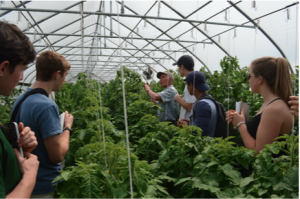
Tomato plants in one of the greenhouses.
Vermont is a leader of the community-supported agriculture or, in other words, the Farmers Market. Because people increasingly want to buy local fruits and vegetables, demand for locally grown foods is very high. About 75 percent of the vegetables grown on the farm are sold through his farm stand, while some products, including strawberries, are sold to bigger grocery stores such as Hanover Co-op. According to Bob, on weekends people will travel forty to fifty miles to purchase products from the farm.
We hope you enjoy your visits to these farms!


